Over the past two years, the nature of work has changed dramatically due to the social restrictions implemented globally in response to the COVID-19 pandemic. Remote work and work from home (WFH) have become an integral part of an employee’s life. Now, as economies reopen and countries lift restrictions, people are happy to return to the office, either five days or two-to-three days a week. These preferences have given rise to a new and evolving hybrid workforce.
What is a hybrid work model?
A hybrid work model means employees can partly work from the office (onsite) and partly remote depending upon the business requirements and their flexibility.
But the shift to hybrid work is not an easy feat. It is a crucial moment that requires companies to ponder complex questions.
- How do they bring people back to the workplace safely?
- How do they foster seamless communication among people working from different locations?
- How can leaders best support the changing needs and expectations of employees? In all, how do they ensure a hybrid work works?
This hybrid workplace guide will help you explore answers to all the above questions, and learn how to design, build, and manage a successful hybrid workforce.
Types of hybrid work models
Before you formulate any hybrid strategy, here are the three parameters based on which you can design your hybrid work model.
A. Work environment
- Remote- first
- Office-first
B. Scheduling
- Split-week model
- Week-by-week model
C. Division of employees
- Remote teams and onsite teams
Based on the work environment, there are two types of hybrid models.
Remote-first
In the remote-first model, employees work remotely primarily. They also have access to coworking spaces and offices. However, it is entirely upon them to work from home or the office. Although this hybrid work model offers employees the flexibility to choose what best works for them, it can lead to unpredictable behavior of employees in an operational sense. That is, workers might end up visiting the office together at the same time, compromising social distancing protocols.
Pros
- Improves employee satisfaction and efficiency
- Streamlines meetings
- Offers workspace for collaboration and meetups
Cons
- Unpredictable as to who is coming when and where
- Overcrowded offices
- Underutilized office spaces
Office-first
The office-first model is similar to the remote-first model, except that the primary work location for employees is the office.
The office-first model is easy-to-implement. Organizations need not change protocols or set up too many digital adjustments. The only adjustments required are in some parts of the policies that concern office attendance.
The office-first model is best suited for organizations whose productivity depends on collaboration. It facilitates teams to accomplish their work without losing flexibility.
However, for some industries, such as construction or manufacturing, the office-first model is the only feasible choice for hybrid work.
Pros
- Promotes teamwork and collaboration
- Little to negligible adjustments required
- Facilitates flexibility
Cons
- Not suitable for a dispersed workforce
- Not the most practical model for companies requiring individual outputs
There are two models based on the Scheduling parameter.
Split-week
In the split-week model, organizations divide the workdays between onsite and remote work. For instance, one department work from the office three days a week. For the remaining week, other departments can come to the office and work. This way, offices won’t be overcrowded, and teams also get a chance to regroup and collaborate constantly.
Pros
- Promotes face-to-face interactions and meetings
- Avoids overcrowding
- Maintains team dynamics
- Allows organizations to experiment with cross-departments
Cons
- Increases operational costs
- Does not facilitate inter-team interactions
Week-by-week
In the week-by-week model, organizations assign workweeks to different departments based on which they come to the office. And for the rest of the weeks, they work remotely.
It is appropriate for organizations with a large number of employees. Organizations can reduce office space drastically and cut down on overhead costs.
However, this model lacks flexibility as urgent meetings or unforeseen events can disrupt the weekly schedules.
Pros
- Beneficial for large organizations
- Implementation can be progressive based on requirements and situations
Cons
- Inefficient when unprecedented events occur
- Little or no face-to-face inter-team interactions
Based on employee division, there is a hybrid model named as-
Designated teams hybrid work model
In this model, organizations assign employees either office or remote work, as per their roles and responsibilities.
For example, companies that need safety checks like power plants and factories need onsite workers. While administrative staff, IT experts, marketing teams, and sales representatives do not necessarily have to be in the office to perform their tasks.
Designated teams hybrid model ensures higher productivity of remote workers. Besides, organizations can save considerable money on electricity and other utilities with half of the workers based remotely.
Pros
- Improves efficiency of remote workers
- Reduces operational costs
- Works for industries focused on labor-reliant output
Cons
- Creates a disconnect between onsite and remote workers
- Increases dependency on digital communication and technologies
Types of Hybrid Models |
Pros |
Cons |
Remote- first |
|
|
Office-first |
|
|
Split-week model |
|
|
Week-by-week model |
|
|
Designated teams hybrid work model |
|
|
Is hybrid model worth the hype? Know how it will impact your business

Over half of the US workers have been working from home full-time due to COVID-19, however, less than one in five would like to do so permanently.
While offices foster better collaboration, the home offers convenience and safety.
And the hybrid model helps balance both.
Employees who have worked in the hybrid model report an uptick in personal creativity, work relationships, and productivity. The added flexibility of WFH facilitates employees to complete their day-to-day responsibilities. Further, employees who spend a significant portion of their time in the office with colleagues feel more connected, engaged, and motivated.
A well-thought-out hybrid work model can be great for collaboration, productivity, employee experience, and safety.
Reasons for adopting a hybrid model
Hybrid work makes more sense in many ways than an onsite model does. Know what makes the hybrid work model the future of work-
Decline in overhead costs
The shift to a hybrid model reduces the number of employees in the office. As a result, less office space is sufficient to accommodate all. And that is where companies can drive down costs substantially in terms of rent, maintenance, office supplies, utilities like heating and air conditioning, and printing and stationery.
Better employee experience and work-life balance
Hybrid work gives employees the flexibility of deciding where and how they want to work. A report by Gallup indicates that highly engaged teams show 21% greater profitability. So, if employees are satisfied with their job, have reduced stress levels, and have a great work-life balance, their performance at work naturally improves, and so does their overall well-being.
Higher safety and social distancing
Covid-19 is a constant threat looming in our personal and professional lives. As companies plan to set up hybrid working environments, sanitization and safety of employees should be of the utmost importance. The meticulously designed offices help maintain social distancing among employees. Besides, companies can leverage technology to know who was in the office and when, to make contact tracing easier, if and when required.
For instance, IoT sensors count the number of people in a building to limit occupancy. These sensors also identify the desks that need sanitization based on their usage.
AI-powered tools ensure the safe return of employees to the workplace by automating the entire process of checking their vaccination status/certificate, screening them for daily health declaration, and creating a roster for them on a rotational basis as part of safety measures and protocols.
Hassle-free collaboration
The hybrid work model debunks the misconception that team members need to be physically present to collaborate for work. Thanks to the technology and various tools that facilitate seamless asynchronous communication, meetings are now location-independent. For instance, a team leader can announce team-related news on Zoom, MS Teams, or Slack group, to promote synergy amongst scattered employees and still give them a feeling of everyone being in the same place and working together.
Boost in employees’ productivity
In pre-covid times, some managers contemplated hybrid working with suspicion, thinking that if employees had the freedom to choose the hours they worked, they would simply choose to do less work.
However, it has turned precisely the opposite. As per Microsoft research, 82% of leaders in Europe found out that their employees have been enormously productive compared to pre-pandemic times.
This is because of the flexibility that employees have achieved. They avoided commuting at peak hours, focused on their work without getting distracted by the interruptions of the traditional office environment, and worked when they were most productive.
Allows employers to access larger talent pools
If your organization offers a combination of in-person and remote working, you can expand your talent net to different geographical locations. The hybrid model allows you to attract and hire the best talent, which otherwise may not be possible. It also brings a great deal of diversity of thought, age, race, and abilities as you do not need to limit yourself to local talent.
Mckinsey report reveals that 75% of employees believe that more diversity is needed in areas, such as ways of thinking – 55%; race and ethnicity – 44%; gender – 33%; age – 29%; and educational background – 27%.
Challenges of the hybrid work model
Every organization operates differently. There is no one-size-fits-all hybrid model that works for every organization. Each organization encounters different challenges in making a hybrid work model successful. Below are some of the challenges that make the hybrid model difficult to adopt as compared to the onsite work model-
Mismatch in expectations of hybrid work
Employers are planning to bring their employees back to the office for at least three days a week, while on the other hand, employees want to work from home for two or more days a week, and 52% want at least three days of remote working.
This evident disconnect between employees and employers can put businesses at high risk of losing new and existing talent.
Thus, every organization should design and develop a model specific to their needs. The company can try various permutations and combinations of different approaches to find what is best for them based on their situation and culture.
Greater cyber-security risks
Remote work has increased the average cost of a data breach by $137,000 – IBM.
Cyber-attacks are among the top five risks in 2020. The irony is that the precarious industry is growing continuously as IoT attacks become more sophisticated and expect to double up by 2025.
Cyber-attacks have become more prevalent in the pandemic as employees use their networks and devices to WFH from different locations. IT staff is overwhelmed with tasks, such as securing digital assets through constant software updates, robust password management, and multi-factor authentication.
Organizations are taking initiatives to train remote workers on things like connecting to company infrastructure securely, backing up data, identifying and reporting phishing emails, and implementing recovery plans in case of outages. Educating employees would inevitably increase their cybersecurity expenditure.
Lack of a level playing field for remote workers
When people work together often, it is relatively easier to collaborate, give feedback, ask for help, participate in meetings, and build solid foundations. But when teams are scattered, a disconnect can develop between remote and onsite workers.
It is also possible that leaders may view onsite employees as more dedicated and give them additional support. Conversely, remote workers may feel overlooked or isolated in training and promotion opportunities because they are less visible in the workplace.
The onus lies on the managers to provide all the workers with equal opportunities, exposure, and evaluations based on their work.
No peer learning of the new hires
This is one of the significant downsides of hybrid working. New hires may find it back-breaking to acquire knowledge from leaders and experienced colleagues in the office due to time constraints and availability issues. It can jeopardize their connection with co-workers if no in-person interaction happens. As a result of which they can end up feeling isolated and frustrated.
Negative impact on culture
The sense of belonging in an organization may not be as strong when people work together physically. Though it certainly takes a toll on remote workers as they feel less connected and out of the loop. The feeling of being an inactive contributor crops up in them and ultimately leaves them wondering if they fit in the workplace or not. Leaders must ensure the employee feels heard to assure the success of their company.
Get the PDF version of this guide to access it anytime
Download NowHow to create a successful hybrid work model strategy?

The onslaught of the pandemic forced companies to leverage technologies that facilitate virtual work seamlessly. However, that swift shift to remote working brought its challenges. The issues did not circle productivity or technology. Instead, these were people-focused challenges, where employees felt the strain on company culture with no room for open collaboration and team cohesion.
Pandemic or no pandemic, this is a red flag for any company that considers itself employee-centric. Moreover, the weakened sense of connections within teams adversely impacts the innovation of core products and services of the company.
A successful hybrid model is the need of the hour to triumph over such situations, as employees and employers have never experienced such disruptions in the recent past.
Many organizations are already experimenting with initiatives and strategies to devise a perfect workforce model. However, most of them are disconnected and may not lead to a holistic, proactive, and forward-looking solution.
Strategizing and implementing a successful hybrid model not only ensures you are doing business right but also creates a culture and fortifies camaraderie that celebrates forward-thinking and traditional teamwork. Creating an optimal solution requires your careful deliberation on the following key fronts-
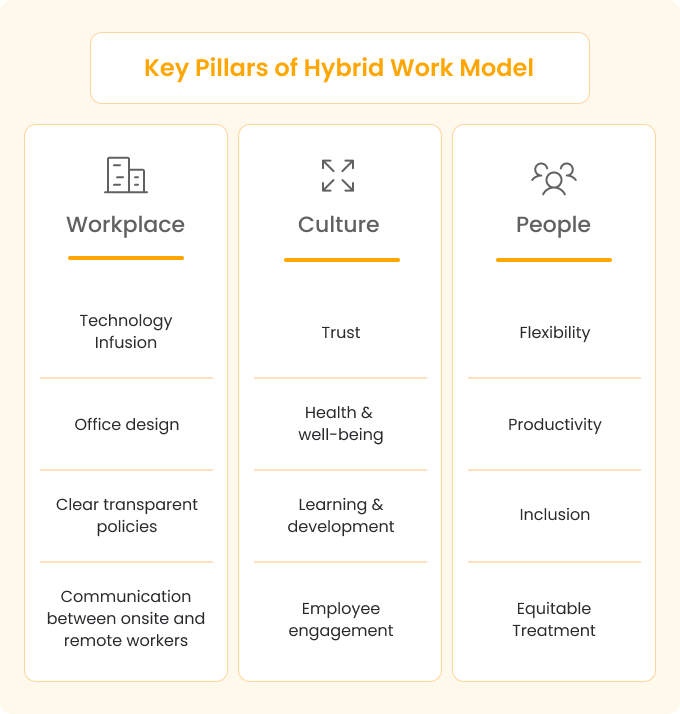
A detailed description of the three key pillars of the hybrid work model will help you gain a better understanding of the factors essential for creating and executing the strategy.
Type of workplace you need to build for the hybrid model-

1. Technology infusion
Whether your employees work from the home or office to find the right balance, they will confront new realities soon. And so will their managers. To make the hybrid model work, employers must face the future with open eyes and the right technology.
Real-time collaboration is the most critical aspect to let hybrid workforces thrive. Technology is the only medium that can keep teams connected and engaged. Technology equips employees to handle any work-related scenarios, irrespective of their locations.
So, whichever tools and technologies enterprises adopt at the workplace, for instance, video conferencing tech, team collaboration platforms, and online resources, employees working from home should have access to similar tools.
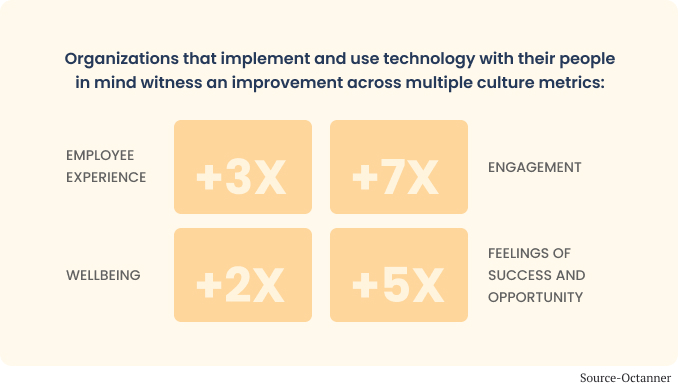
If you want to become a resilient, future-fit organization, then you need to reconsider your technology requirements, processes, and tools to empower dispersed workforces.
Here are a few tools and technologies that you should consider using at your workplace-
a. Collaboration tools
Employees can use team collaboration tools or software to track their progress on projects. The collaboration tools include cloud storage, document synchronization, file-sharing software, instant messaging, and online whiteboards, to name a few.
b. Document management
Organizations need document management tools to store documents of all the employees at a centralized location and access them as and when needed. Or you can leverage AI-powered tools to manage your employees’ documents without overtaxing your HRs. The document management tools also help you set role-based access to define who can access, edit, and manage documents.
c. Integrated HR Service Management Solutions (IHRSM)
IHRSM software is critical for the success of your organization and hybrid work model. An IHRSM suite encompasses several modules like core HR, talent management, workforce management, service delivery, document management, case management, and employee onboarding.
An AI-driven tool is more effective for HRs to manage dispersed workforces. The smart virtual assistant (VA) addresses employees’ queries without any intervention from HRs. For instance, a remote worker wants to know about their previous month’s salary deduction. So, instead of reaching out to HR, they can simply ask the VA and get the answer immediately.
Want to see how it works? Book a 1:1 demo today!
SiGN UP HEREd. Office capacity management tools
Organizations must follow social distancing recommendations and safety protocols to prevent the spreading of the virus. As this applies to the workplace also, organizations should ensure that employees coming to the office are within acceptable limits. You can use capacity management tools to count employees as they enter and leave the office premises. The registration tools or occupancy sensors prove effective for a larger workforce.
e. Onboarding applications
With employees having the flexibility to work from home or office, organizations must have a plan in place to onboard employees remotely. As per the State of Employee Onboarding in the US report, the disconnect between the hiring and onboarding process is the organization’s top onboarding challenge. The report also indicates that 87% of respondents are very committed to adopting artificial intelligence for the hiring and onboarding process.
AI-powered tools automate the onboarding process right from the time organizations release offer letters to the candidates. You can leverage these tools to make your employees’ onboarding experience seamless and engaging from the beginning.
f. Performance management tools
The hybrid work model may not allow managers to see their team members often. This does not mean managers can not keep track of their goals and success. Performance management tools enable managers to regularly measure their teams’ performances and provide timely feedback.
g. Security software
Flexible work environments require companies to take a strategic approach for safeguarding their organizations from intruders. Many organizations use VPNs, however, VPNs can leave them vulnerable to attacks. Sometimes, VPN authentication gives users unauthorized access to the corporate network. That is why many organizations look at alternate remote access solutions, such as zero-trust network access.
h. Daily healthcare checks
The fundamental cause that led to the transformation of work forever is the pandemic. As we shift to the hybrid workplace, it is the collective duty of employees and employers to keep the workplace safe by following the specified guidelines. The employees must get themselves vaccinated before rejoining the workplace.
Organizations can harness the power of AI to keep a tab on employees’ vaccination status and ask them to upload their certificates on the platform. You can screen employees daily to further check their health status and protect others at the workplace.
Organizations can also embrace new touchless technologies to replace surfaces such as buttons and handles to maintain hygiene at the workplace and address health concerns amplified by Covid-19.

2. Greater focus on office design
McKinsey’s report reveals that 9 in 10 companies are switching to a hybrid work model. As organizations join this new bandwagon, they are reconsidering optimizing their office designs for fostering innovation, encouraging co-creation, and problem-solving among employees.
Forward-looking companies are getting past the desk-chair paradigm to focus extensively on collaborative, community-like spaces for employees. Employees want their ideal workspace to have more open areas for teams. Open spaces facilitate movement and random interactions with colleagues that employees value. These types of encounters leave a positive impression on the individuals and foster innovation to benefit the organization as a whole.
According to Microsoft research, 66 percent of employers are redesigning their offices to meet the new demands of hybrid work.
Besides, you can easily morph open spaces as new work patterns emerge. There may also be dedicated areas for mentoring, learning, and training – something that Gen Z has been missing for the last 22 months. By creating spaces that are creative and less structured, you can reframe the office as more of a destination than an obligation.
In the longer run, if real-estate designers want to reduce excessive space and repurpose workspace designs, they can make informed decisions using data generated by IoT sensors and devices. This data will give the planners insight into how the space is used in real-life as opposed to in theory. The insights would help them make the right decisions at the right time, thereby avoiding costly miscalculations and disruption to the overall workspace environment.
As part of this process, they can consider hot-desking, where employees no longer need to maintain their own dedicated space. For example, when an employee arrives at the office, they can sit in a different spot each day. Organizations need to figure out how they can facilitate and organize that space both physically and technologically, to show employees where they might be sitting that day, all the while ensuring that the employee experience is virtually the same from desk to desk.
3. Clear, transparent policies
Hybrid work policies define companies’ expectations from their onsite and remote workers. Ideally, an effective hybrid work strategy should focus on employees’ health and well-being. It should be flexible, responsive, and fluid to accommodate the changing demands of employees and simultaneously bridge the gap between remote and onsite employees.
A survey by Gartner indicates that 49% of 238 surveyed HR leaders do not have an explicit hybrid work strategy, while one-third of HR leaders reported that their work strategy focuses exclusively on hybrid and/or remote work in 2022.
The hybrid work strategy should be well articulated to bring efficiency. That is, communication lines, technology, and processes must be clearly defined. To begin, organizations can decide what hybrid means to them, and then how they can instill it fairly and realistically.
Once you create these guidelines, you can uncover gaps in your company documentation and explore new ways to support your employees comprehensively.
4. Communication between onsite and remote employees
Managing global teams in a hybrid manner is a daunting task. Because someone from the team will inevitably be working remotely as per the hybrid work model. So, even if teams had good coordination in pre-covid times, it can leave remote workers frustrated due to their inability to participate equally, and hence feel less engaged. It is especially true when teams collaborate on creative and innovative work, such as brainstorming, which often uses analog whiteboards or other physical products that are difficult for remote employees to comprehend.
Organizations can avoid such situations by installing additional lighting, extra speakers, in-room microphones, mobile tables, and easy-to-move marker boards and displays in the offices.
Besides, the organization’s focus should be to leverage technology and foster the idea of clear communication. Communicating a clear vision and goals to employees at home or in the office lets them understand the nitty-gritty of the project and how their work fits into a bigger picture. Adequate communication keeps them engaged, stress-free and reduces the chances of burnout by making their work and participation more meaningful.
Type of culture you need to build for the hybrid model

1. Trust
Trust is the bedrock for nurturing any relationship especially, between an employer and its employees. Even after the successful venture into remote working, some managers think that remote workers exploit their freedom and regularly slack off. Due to the less visibility to management, leaders fall into the trap of setting up remote monitoring systems to compensate for the lack of visibility and keep productivity high.
Managers need to trust their remote employees without micromanaging them.
Gartner’s research shows that employees who are trusted at the workplace are more engaged than those who are not.
Trust is a critical component in helping employees acclimatize to the post-covid office environment and meeting their needs. Organizations that want to retain top-performing talent should build hybrid work strategies that trust employees in their choice of where and how they decide to work. To get this right, organizations should prioritize the flexibility of their employees while also creating an inclusive workplace culture. You can encourage your employees to foster personal connections and facilitate networking and development opportunities for interested employees.
2. Health and well-being
A study by Glint shows that in July 2020, nearly 3 out of 4 employees between the ages of 24 and 38 expressed high interest in more employer-sponsored mental health and well-being support.
Stress and burnout have become real concerns during the pandemic. “Zoom fatigue and collaboration overload” are ruling the lives of employees. If you want your employees to return to the workplace, you need to make their health and well-being a boardroom priority. Health and well-being can be broken down into three categories to plan realistic strategies around each –
a. Safety and security
Holistic health and well-being are the key dimensions of performance excellence. Pandemic has taught companies to keep their employees safe and infection-free. Some companies are hiring chief health officers, combined with DEI accountability. It is because people’s health is directly related to their feeling of belonging and their mental and emotional well-being. For hybrid work, this means companies need to focus seamlessly on the safety and security issues of their remote and onsite employees.
b. Personal fitness and physical well-being
A hybrid work model impacts employees’ physical health and well-being too. When offices were closed during lockdowns, some companies started nutrition, exercise, and mental health programs for their employees.
Undoubtedly, company gyms have been the linchpin of big tech firms like Google and Apple forever. However, subsidized health club memberships have become a familiar employee benefit now.
With the redesigning of office spaces for hybrid work models, companies are inspired and ready to build fitness facilities in their offices, including workout rooms, yoga studios, and walking tracks.
Organizations can also provide meal services to employees. Nutritious food will boost energy levels, reduce absenteeism and healthcare costs of employees.
c. Psychological and emotional well-being
With no face-to-face interactions, increasing work pressures, and work-life balance on the toss, employees’ emotional and mental well-being goes into turmoil. Moreover, their attitude towards life and work becomes gloomy.
The growing issues of burnout, stress, and mental health concerns of employees in the hybrid workplace model have compelled companies to build a culture that facilitates open and honest conversations among all.
Leaders should be more empathetic towards employees’ needs, provide them forums to voice and address challenges, allocate tasks reasonably, establish formal and informal support groups, and have opportunities to disconnect from work.
3. Learning
Inculcating the culture of continuous learning in the organization can help businesses evolve and gain the agility to succeed in the digital era. While learning strategies are critical for organizations, they require an overhaul. Around 50% of the organizations are planning to renew their learning strategy as a part of their mission, to maintain the pace with changing environment, meet the preferences of modern learners, and add value to employees’ careers.
“Virtual learning will constitute at least 40 percent of the formal learning structure, with some organizations expecting this figure to reach as high as 90 percent” – Deloitte.
The hastened adoption of digital technologies fueled by COVID-19 has led to the recreation of the best of in-learning through live video and social sharing. This transformation has empowered organizations to scale their learning efforts cost-effectively and permit greater personalization for learners.
4. Employee Engagement
Culture and engagement are no longer nebulous topics owned by HR. Instead, they have become the most attention-seeking issue that companies face globally. 87% of companies cite culture and engagement among their top challenges, and 50% call the problem very important.
Research has shown that a strong culture effectively improves business outcomes and drives growth. Employee engagement is a direct outcome of robust company culture.
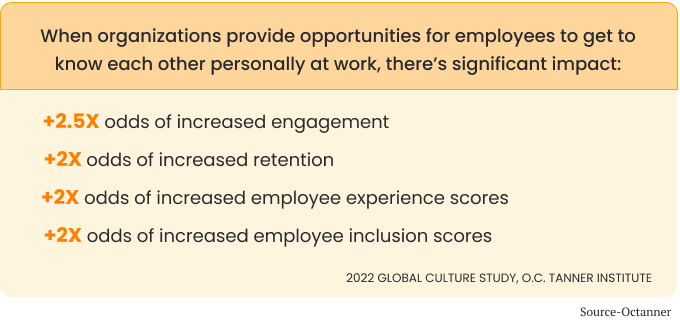
A high-performance culture encompasses behaviors that empower your organization to achieve desired results by setting business goals, defining employees’ goals & responsibilities, creating a transparent environment, and encouraging employees to focus on their learning and development.
Organizations that succeed in creating a culture that infuses meaningful work, optimal employee engagement, job & organizational fit, and strong leadership outperform their peers and beat their competition in the war of talent.
Companies can benefit from an AI-powered engagement platform to acquire real-time sentiment and employee feedback. The AI-powered tool sends regular pulse surveys, and analyzes employees’ sentiments to help leaders identify where the engagement is high and where the problems are cropping up, and accordingly address the issues.
Type of people practices you need to build for the hybrid model

1. Flexibility
The hybrid model is analogous to flexible working. Flexibility ensures that there are no fixed rules regarding working hours and location primarily. Companies can experiment with different hybrid models. Managers can discover what is best for their teams by letting workers decide where they want to work. Flexibility also boosts productivity as employees work at their convenience and when they are most productive.
It may be a good idea to survey employees to know their working style preferences and reduce the complexities of accommodating different employee needs. Once you have created an accurate sense of your employees’ needs and priorities, you can start to work your way through the challenges and decisions that you need to make for an effective transition to hybrid work.
Here are the survey questions that you can ask your employees to know their work preferences and create the perfect hybrid work strategy.
Resource Alert: Hybrid Work Preference Survey
2. Productivity
Maintaining and enhancing productivity from both in-office and remote, especially when teams are a mix of both types is a crucial part of unraveling the puzzle of sustained hybrid work models. The traditional view towards productivity may no longer suffice. It is essential to note that not all employees have access to high-speed internet, designated home workspaces, or distraction-free environments. A remote worker might feel in a disadvantageous position if employees seen in the office are perceived to be more productive.
Leaders should empower each team member of their organization to make decisions that best support their productivity and well-being. Also, have regular check-ins to ensure they feel supported.
3. Inclusion
Creating an inclusive environment for all employees becomes even more critical for organizations operating in a hybrid setup. Managers and HRs should build an inclusive work environment where remote employees do not feel unequally treated compared to onsite employees. But if organizations are not careful, this exactly can happen.
If you implement a hybrid work model, ensure that your organization has different communication channels available, irrespective of the employees’ location. Further, you can-
- Ensure everyone is heard in a virtual meeting
- Review how work is assigned. For instance, don’t preserve certain clients only for in-person sales calls.
- Listen to employees- Roll out pulse surveys to know what employees need from the organization to feel connected and heard.
4. Equality
Employers who treat employees with fairness and equality witness a boost in their morale and motivation on the job. However, in a dispersed workforce, employees do not receive the output (monetary and non-monetary) for the input (time and effort) they put in.
In a hybrid work setup, if remote workers feel that managers are skewed towards onsite employees, either inherently at an individual level or, when compared with other colleagues in similar roles, it can lead to disengagement and discontentment eventually.
Unconsciously backing in-office employees, also known as distance bias/proximity bias, can induce serious consequences for a business, such as low productivity and increased attrition.
Another massive problem of distance bias is the loss of top talent. A biased environment can make remote and hybrid employees feel that their career trajectory and earning potential are undermined.
Organizations should treat their employees fairly and equitably to leverage their full potential and drive business growth.
Best practices of hybrid work model

There is no other way of creating high-performing teams in the new virtual and hybrid workplace than getting the basics right. A fusion of organizational and human-centric principles can help you transition to an efficient work model that will engage employees and align with the ecosystems’ needs.
Here are the best practices that managers and leaders should refer to –
Promote work visibility
Bolster a culture where employees proactively and explicitly share their work and make it visible to each other. Encourage people to take time out for informal connections and conversations, to listen to what is unsaid.
Schedule transparency
Be clear on who is working from home and the office. In a flexible workspace, an open line of communication would ensure optimal productivity and help maintain a collaborative environment. Being aware of employees’ work hours will prevent messaging or calling them at inappropriate times, especially when they are working in different time zones.
Define the new rules of engagement
Take time out to understand the unique position of your employees. They may be juggling childcare and homeschooling, eldercare, dealing with feelings of loneliness, or social isolation. Be accommodating when you can, in terms of how they perform their role and take time off to fulfill family responsibilities.
Spark the human connection
Be amicable with your teams. Ask employees in meetings how they are doing. Be willing to be vulnerable and share your challenges. Turn on your video during team calls to engage in a more empathetic way.
Provide necessary resources
Ensure that employees have access to the right mix of digital platforms, endpoint devices, internet connectivity, and adequate sound, lighting, and video capabilities to participate effectively in virtual collaboration and deliver expected outcomes.
Be kind and empathetic
Team managers and executive leadership should practice empathy and kindness. Look out carefully for the signs of remote fatigue in employees and help them overcome it by creating an inclusive, healthy, and safe workplace.
Let team members set their work hours and workplace
Allow your teams to specify their availability for collaboration and individual work as long as they are participating in all the team activities and delivering expected outputs.
Set guidelines for meetings
Organize team meetings once you have decided its purpose, timing, duration, and location. Include remote and onsite team members to ensure equal-opportunity participation in the meet-up.
Already switched to hybrid work model? Here’s how you can track if it’s working for you
Gauging the profitability of a business is pretty straightforward. But have you tried analyzing how your dispersed workforce is functioning? Are they engaged, healthy and safe, and content with their job?
Are there signs and metrics you can use to evaluate your employees’ performances? The answer is yes, and in many respects, it comes down to transparency, communication, and support.
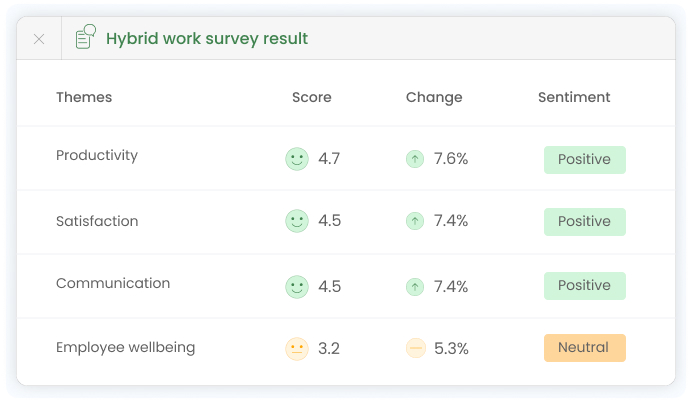
Simple pulse surveys are instrumental in assessing how employees feel about their jobs and workplace. Instead of saving your questions for an annual survey, make it a point to reach employees through weekly or monthly surveys.
Leena AI can help you build and effectively manage a successful hybrid workplace. Our diverse range of products, HR Service Delivery Suite, Employee engagement, Covid-19 workplace response suite, empowers organizations and HR leaders to provide a holistic and harmonious experience to their employees.
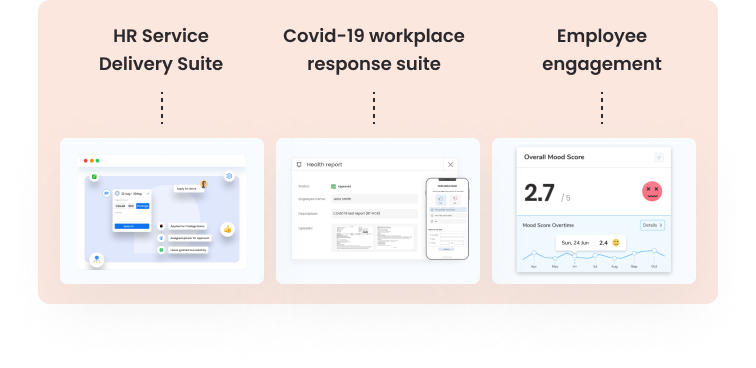
Examples of how our expertise and AI-powered tools can help include:
- Partnering with your teams to seamlessly deploy the solution and make employees familiar with the solution.
- Supporting your executive leadership to embed and sustain change
- Freeing HR from answering redundant and repetitive queries to let them focus on more strategic tasks.
- Rolling out surveys to gauge employee engagement. Provide detailed reports to highlight areas of improvement and avoid attritions.
- Ensuring safe return to the workplace with vaccination status tracking and regular health updates/declarations.
Download the pdf version of this guide from here.
It’s time to emerge stronger in the hybrid era
The spin to hybrid work environments has just begun. The hybrid workforce model has changed everything from the way we commute to the way we interact with others far and wide. It has brought an irreversible impact on our lives.
The transition to the hybrid model is not easy as companies would need to ensure the seamless coexistence of different types of employees. Organizations will need to go digital and revolutionize for growth on the new S curve. Their future-focused planning should place humans at the center, technology at speed, and innovation at scale as the key drivers of transformation. Companies already reinforcing these values are proving more resilient in the new equilibrium and beyond.
While the hybrid work model strategy might differ for each organization, based on the business’s unique context, it is crucial to understand, consider, and carefully conceive each of the contributing factors responsible for a supportive workplace, dynamic culture, and sustainable people practices.
See how Leena AI can set you up for success like it has done for Coca-Cola, Vodafone Idea Limited, AirAsia, and many more.






